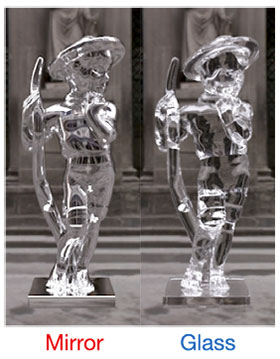
ここからコンテンツです。

Model for distinguishing materials like a human being does
Is this material reflective or transparent? Hideki Tamura
A research team including Hideki Tamura, an assistant professor in the Cognitive Neurotechnology Unit of Toyohashi University of Technology's Department of Computer Science and Engineering and Justus Liebig University Giessen’s Faculty of Psychology has proposed a model that makes it possible to distinguish materials using computer imaging based on judgment criteria similar to the criteria used by humans. This research used two different types of material to be distinguished: a reflective material that reflects its surroundings like a mirror or metal surface, and a transparent material that allows the view of its surroundings to pass through it like glass or ice. The research suggested that humans use the existence of imagery clues when distinguishing between these different materials. The results of the research may have applications in imaging technologies for the accurate depiction of textures at low cost.
Humans have the ability to sense texture in order to estimate the conditions of a surface or the quality of a material. This enables us to sense rich texture from, for example, the beautiful glitter of a precious metal or the colored, translucent line of light from a jewel. Throughout history, humans have always prized high quality textures and the intricate reflections and transmissions of light on the surfaces of objects. Against this backdrop, the effort to understand the human brain's processing of texture sensing has actively been conducted across various academic fields such as engineering, psychology and neuroscience.
A reflective material like a mirror or polished metal has specular reflections on its surface. Transparent materials like glass or ice allow light to pass through and light refracts inside them. For these two types of material, the image visible on the surface of the material may change in significant and complicated ways depending on the material's surroundings. Therefore, there are countless possible permutations, and it has been largely unclear how humans distinguish between them.

This led the research team to conduct psychophysical tests to discover how accurately humans distinguish between reflective and transparent materials. The team also verified how accurate convolutional neural networks (CNNs) could be when making the same distinction. The test showed that a human being could distinguish between reflective and transparent materials at 78% accuracy while the CNN could make the same distinction at 94% accuracy, which is considerably more accurate than humans.
From these results, we can see that the CNN’s accuracy is great enough to create potential for industrial applications where it may replace human observers. However, the question we really want to solve is, "How do humans distinguish between the two different types of material?" The research team concluded that it would be hard to outperform humans in identifying the image clues that humans perceive from the structure or behavior of a model.
Therefore, we tuned the CNN not only to answer correctly as humans do, but also to dare to "make mistakes as humans do," and verified what is used as a cue based on the structure of the model and its similarity to humans. The results showed that a relatively shallow model with three layers of CNN convolution structure was the most similar to that of humans, suggesting that the model may use image changes that appear on the top of the object as a cue. These findings support the insights into human texture sensing reported in previous studies.
This research became the first to successfully structure a model that enables image computing and distinguishes between reflective and transparent materials while imitating a human being’s correct and incorrect answers. Applying this model may make it possible to distinguish between materials and reproduce textures based on summarized data without having to use all of the data in an image. In other words, we can expect that there will be applications for this model in technologies achieving the highly accurate reproduction of textures at low cost.
Reference
Tamura, H., Prokott, K. E., & Fleming, R. W. (2022). Distinguishing mirror from glass: A "big data" approach to material perception. Journal of Vision, 22(4):4, 1-22.
https://doi.org/10.1167/jov.22.4.4
ヒトのように物体材質を識別するモデル
この物体は反射/透過している?田村 秀希
豊橋技術科学大学情報・知能工学系認知神経工学研究室の田村秀希助教と独ユストゥス・リービッヒ大学ギーセン心理学科の研究チームは、ヒトと同じような判断基準で物体材質を識別する画像計算可能なモデルを提案しました。特に、鏡や金属の表面のように周囲の空間像を反射する「反射材質」と、ガラスや氷のように周囲の空間像が透過する「透過材質」の2つの材質を、今回の識別対象とし、ヒトがこれらの材質を識別する際に利用する画像手がかりの存在が示唆されました。本研究の成果は、質感を高精度かつ低コストに表現する画像技術への応用が期待されます。
私たちには物体の表面状態や材質を推定する「質感認知」の能力が備わっています。それにより、貴金属が生む美しい輝きや、宝石からこぼれる色づき透き通る光の道筋から、私たちは豊かな質感を感じられます。太古から現代まで常に人類全体で、良質な質感を追求し、光が物体表面で複雑に反射・透過することに価値を感じてきました。このような背景から、脳内の質感認知処理の理解が工学・心理学・神経科学といった様々な学問領域で積極的に進められています。
鏡や研磨された金属のように光がその物体表面で鏡面反射する「反射材質」と、ガラスや氷のように光がその物体を透過・屈折する「透過材質」は、それらの物体表面に映る画像が、物体の周りに何があるかによって大きく複雑に変化します。そのため想定される状況は数え切れないほど存在し、ヒトがどのように両者を見分けているか、ほとんど明らかになっていませんでした。
そこで研究チームは、ヒトがどれくらいの精度で反射・透過材質を見分けているかを心理物理実験で調査すると同時に、畳込みニューラルネットワーク(CNN)のモデルがどの程度の精度で識別できるかも検証しました。実験から、ヒトは78%の精度で反射・透過材質を識別できるのに対し、CNNは94%とヒトと比較してかなり高い精度で識別できることがわかりました。
以上の結果は、単にモデルの識別精度という点では申し分なく、ヒトを代替する存在として産業応用できる可能性を秘めています。しかしながら、私たちが本当に明らかにしたいのは「どのようにヒトが両者の材質を識別しているか」という点であり、ヒトを凌駕するモデルの構造や振る舞いからは、「ヒトが使っている画像手がかり」を見つけ出すことは難しいと考えました。
そこで、ヒトと同じように正解するだけでなく、あえて「ヒトと同じように間違える」ようにCNNをチューニングし、そのモデルの構造やヒトとの類似性から、何が手がかりとして使われているのかを検証しました。その結果、CNNの畳み込み構造は3層という比較的浅いモデルがヒトと最も似ており、モデルは物体の上部に表れる画像変化を手がかりとしている可能性が示唆されました。これらは先行研究で報告されている、ヒト質感認知の知見を支持するものでした。
本研究は、ヒトの正解/不正解を模倣しつつ、反射・透過材質を識別する、画像計算可能なモデルの構築に初めて成功しました。これを応用することで、画像中のすべての情報を使わずとも、要約された情報で材質識別や質感再現が可能になるかもしれません。すなわち、高精度な質感再現を、低コストに実現する技術への応用が期待されます。
Researcher Profile

| Name | Hideki Tamura |
|---|---|
| Affiliation | Department of Computer Science and Engineering |
| Title | Assistant Professor |
| Fields of Research | Vision Science / Kansei Informatics |
| Graduated KOSEN | National Institute of Technology, Oshima College |
ここでコンテンツ終わりです。
